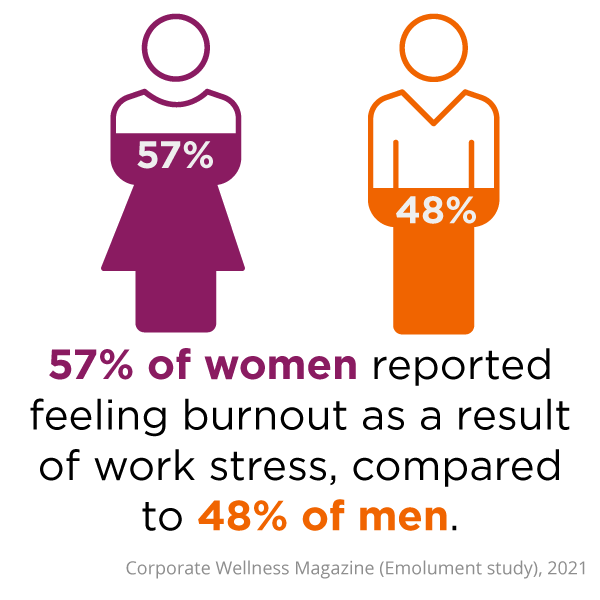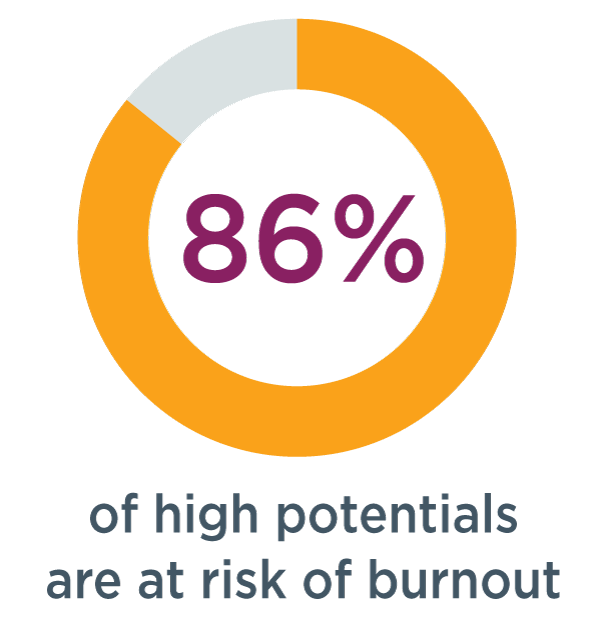Women in the workplace are facing more stress than ever before. During the pandemic, many women took on new and expanded roles in and out of the workplace. Even though they make up more than half of the workforce, women continue to be responsible for most household tasks, including child care. With regular disruptions to schools and daycares, plus new job responsibilities as organizations seek efficiencies, many women are holding on by a thread, and a record number have left the workforce altogether. Now companies are grappling with how to help their women employees overcome burnout.
Consider this all-too-common scenario:
A few girlfriends finally gather for that night out they’ve been trying to plan for months. But at each attempt, the texts roll in: “I’m out. Luke has basketball practice, ” or "Need to cancel. Sitter’s in quarantine.” And, “Sorry, stuck in a meeting, ” or “Two more people resigned today. Another late night.”
Once these ladies are eventually together, there’s often a boisterous chorus of “I’m so stressed!” You might hear similar sentiments in the office breakroom or during the chit-chat at the start of a virtual meeting.
Working women have always faced unique challenges, but workplace burnout is more than stress. In this blog, I’ll cover the difference between stress and burnout, share common triggers for women, and the warning signs your women employees are burnt out. I’ll also give you some tips to help women overcome burnout at work.

The Progression to Burnout
Stress can cause you to feel disheartened or frustrated, but can be improved by slowing down, problem solving, or taking a vacation. Burnout, however, is the feeling of chronic, unrelenting stress accompanied by intense negative feelings such as hopelessness, exhaustion, and disillusionment. Motivation dries up and obstacles may feel insurmountable.
The pandemic and the Great Resignation have taken a toll on all employees, but women are even more burned out now than they were a year ago. Burnout is escalating much faster among women than among men, so if you have women on your team—be aware.
According to McKinsey’s Women in the Workplace research, one in three women say they have considered downshifting their career or leaving the workforce in 2021, compared with one in four who said this a few months into the pandemic. Additionally, four in ten women have considered leaving their company or switching jobs—and high employee turnover in recent months suggests that many of them are following through.
Progression into job burnout can happen quickly. A team member’s reaction may change from “That’s kind of annoying/frustrating/disappointing” to “I just can’t take it anymore!”
External and Internal Burnout Triggers Women Experience
Women are more likely to experience burnout stressors or triggers, i.e., the things that really push their buttons. Triggers can be a combination of external (what’s going on around you; things happening at work) and internal factors (who you are; your personality or tendencies).
According to Dr. Geri Puleo, the most common external or workplace triggers are (listed from most-to-least common):
- Poor leadership
- Lack of organizational caring
- Negative coworkers
- Politics or sabotage
- Lack of resources
- Overemphasis on ROI
- Work overload
- Poor communication
In addition, some workplace conditions are more likely to affect women. Considering that women tend to stay in the same job much longer than men, they can have longer exposure to work-related stressors, including:
- Gender exclusion. Women often report a high level of stress in male-dominated occupations where they have to work harder to prove an equal level of competence with their male counterparts.
- Hostile social interactions and verbal abuse. Many women may have to interact with a boss and/or coworkers who are disrespectful toward or have a bias against women or mothers.
- Sexual harassment. Yes, still. Including physical, verbal, and cyber harassment.
- Lack of emotional support. Too few bosses offer empathy and understanding, simply resigning to “I can’t relate” or even dismissing their female team members’ concerns or frustrations.
- Pay gap. A woman’s income level (compared to her male counterpart’s) is closely linked with anxiety and depression, even in executive-level jobs.
Personalities for Women That Can Drive Burnout
As for internal burnout triggers, certain personality traits can make some people more likely to burn out. As you get more familiar with your team members, you’ll see their personalities emerge.
Pressured by high expectations and juggling multiple roles at home and at work, women will sometimes show signs that they’re on the way to burnout. Do you recognize any of these tendencies?
The Overachiever
The Overachiever thinks everything is important and urgent. They don’t just go the extra mile; they go the extra marathon, exhausting themselves.
The Overachiever is continually adding more and more to their plate; broadening their skills, assignments, and responsibilities.
They might ignore family, friends, and their own wellbeing in order to succeed in their career. Most overachievers have self-doubt and self-criticism, so they strive to prove that they have what it takes—although mostly to themselves.
The People Pleaser
The People Pleaser doesn’t want to let anyone down or to look bad. People Pleasers, like Overachievers, can’t say “no.”
If a coworker is being mean or degrading, that can be especially hurtful and stressful to a People Pleaser. They’ll work even harder to make things right.
If a leader—whether formal or informal—is a People Pleaser, they might be overly nurturing with their teams. They don’t want to abandon the people who depend on them. They’ll try to protect the team at all costs, bringing unnecessary stress to themselves.
The Perfectionist
While the Overachiever goes broad when tackling assignments, the Perfectionist goes deep. They have a difficult time determining when something is “good enough,” so they keep going and going.
Perfectionists tend to fall into two categories: “excellence-seeking” and “failure-avoiding.” The first kind of Perfectionist fixates on achieving excessively high standards; the second is obsessed with not making mistakes.
While Perfectionists have been found to be more motivated and conscientious than their non-Perfectionist peers, by throwing all their energy at one task, they may inadvertently neglect others along the way or miss the value of maintaining positive relationships with their coworkers.
The Knight
The Knight wears an armor. They have a façade up and worry that they could be “found out,” i.e., that they are not doing as well as it might seem. They have a very strong fear of failure and, so to avoid it, they march on, working harder and harder.
Knights are not comfortable being vulnerable in the workplace. Sometimes, because of their personality, but other times because of their workplace culture.
Members of historically excluded groups—where people encounter biases based on their identity groups (e.g., women, people of color, LGBTQ+)—can become Knights in an (sometimes futile) effort to overcome others’ assumptions.

Signs of Burnout in Women Employees
The initial symptoms of employee burnout are often subtle, and they encompass a wide range of warning signs. A lack of energy turns into total exhaustion. Sleepiness turns into full-blown insomnia. A few sniffles develop into a cold that just won’t go away.
With so many responsibilities, it can be tempting for women to dismiss or deny the symptoms of burnout, such as insomnia, exhaustion/fatigue, chronic cold, rash, cardiovascular issues, gastrointestinal disorders, depression, and many more. While many of these symptoms can go unnoticed for quite some time, especially at work, be on the lookout for your team members to be:
- like a zombie or a little spacey, just going through the paces
- discouraged or frustrated
- angry or apathetic
- irritable and losing their patience easily
- lacking passion for their work
- missing deadlines
- displaying a sense of humor that’s become more sarcastic
- taking longer or struggling to problem solve or make decisions
- absent or late to work
Tips to Help Women Overcome Burnout at Work
What’s a leader to do?
Be aware of the workplace and personality-driven triggers affecting your women employees.
Here are some ways to help women avoid workplace stress and overcome burnout:
1. Be a champion for work/life balance.
Champion structural workplace policies and benefits that protect and prioritize work/life balance, such as flexible work hours, guardrails around off-hours communications, remote work options, and paid leave. These have become especially important during the pandemic when daycare or schools may be closed.
2. Combat work-related stress.
Encourage use of wellbeing or stress management programs through an Employee Assistance Program. Go the extra mile to enrich team interactions. This can be accomplished with some rapport building through informal conversation at the start of meetings (in person or virtual).
3. Set realistic performance goals.
Remind your team members that neither “above and beyond” or perfection is expected. Get the team member’s input on their performance goals and agree to what’s feasible. Give clear guidance, as ambiguity can lead to anxiety and stress; be clear about what team members need to do and how to best get it done.
4. Prioritize diversity, equity, and inclusion.
Enforce policies to minimize workplace bullying and/or report any sources of gender discrimination. Cultivate inclusivity and consider diverse points of view in problem solving.
5. Offer merit-based incentives.
Show team members that they are valued by recognizing and rewarding good performance. And remember, while monetary bonuses, raises, and promotions are a great way to honor hard workers, there may be other incentives you can offer more regularly. Consider giving team members an early dismissal day, public accolades in front of executive leaders, or a company-sponsored lunch to celebrate recent success.
6. Provide day-to-day support.
Help team members prioritize work and be mindful of assigning work evenly and fairly. Create a psychologically safe environment by encouraging team members to candidly share with you—not just facts, but feelings. Ask, “How are you?” but not as passing pleasantry. Listen and respond with empathy; show that you care.

The Importance of Recognizing and Preventing Burnout in Women at Work
So what does it mean to your organization when your team members have reached the point of “I just can’t take it anymore?”
They can remain in the role, likely with a steep decline in productivity, creativity, reliability, and engagement. Or, they can leave.
When burned out team members leave, they take with them their experiences, organizational knowledge, ideas, and diverse perspectives. Yet, companies are not recognizing or incentivizing burnout reduction efforts. And by not doing something about burnout, they risk losing the very leaders they need right now. While 87% of companies surveyed agreed that it was “very” or “extremely” critical that managers support employee wellbeing, only a quarter do much about it.
Despite their own increasing levels of burnout, research indicates that women are much more likely than men to take action to fight it. All leaders, however, can help manage their team’s workloads, support diversity, equity, and inclusion efforts, and simply check in on how employees are doing. And those things make a difference. According to McKinsey and Lean In’s Women in the Workplace 2021 report, when managers actively managed the workload of their team, their staff was 32% less likely to be burned out and 33% less likely to leave.
But companies should also keep a pulse on how leaders themselves are feeling when it comes to burnout. According to DDI’s Global Leadership Forecast (GLF) 2021 research, one in four leaders who felt used up at the end of the workday planned to leave their organizations within a year. And when leaders have been identified as high-potential employees, they are even more likely to experience burnout. These high performers are twice as likely to leave as peers who indicated they weren’t burned out at the end of the day.
You Can Help Women Overcome Burnout
The evidence is clear. Having women in the workplace is simply good business:
- DDI’s Diversity & Inclusion Report found having a higher proportion of women and minority leaders is the most strongly linked factor to financial performance.
- In our study, we found that organizations with above-average gender and racial/ethnic diversity had at least 30% women and 20% leaders from diverse racial/ethnic backgrounds in leadership roles. These organizations were eight times more likely to be in the top 10% of organizations for financial performance.
You can’t achieve these results without engaged, energized women on the team. Remember the top-two reasons for burnout:
- Poor leadership
- Lack of organizational caring.
Then take a moment to think about the women on your team, and what you’re doing to prevent burnout, not just handle the aftermath. How does your workplace—your leadership—support their wellbeing? Do you have the policies, programs, resources, and culture to help them be their best? If not, advocate for change.
Do you have candid conversations that might reveal some struggles (knowing that “I’m fine” could be a comfortable cover for what’s really going on)? If not, get comfortable with being a little uncomfortable.
Burnout can last for a year or longer, and that’s much too long for a person (and team or organization) to endure. As a leader, you can greatly affect, and work to constantly improve, women’s quality of life. And in turn, their quality of work.
Register for our upcoming webinar, How to Rebuild the Lost Generation of Women Leaders.
Lisa Werner is a Senior Consultant in DDI’s Product Development group, where she creates assessment and learning solutions. She finds inspiration in walks in the park, podcasts on entrepreneurship, and Sunday morning thunderstorms.
Topics covered in this blog

